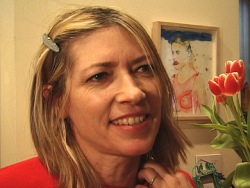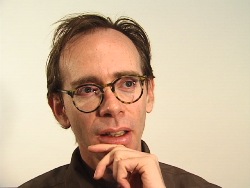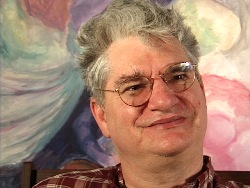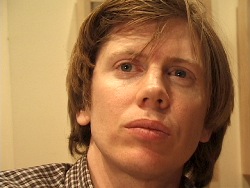
EAI PRESENTS AT MONKEYTOWN
DECEMBER 2005: TONY OURSLER
Synesthesia: Interviews on Rock & Art
EAI PRESENTS AT MONKEYTOWN
DECEMBER 2005: TONY OURSLER
Synesthesia: Interviews on Rock & Art
58 North 3rd Street, Williamsburg, Brooklyn
EAI PRESENTS AT MONKEYTOWN
DECEMBER 2005: TONY OURSLER
Synesthesia: Interviews on Rock & Art
58 North 3rd Street, Williamsburg, Brooklyn
EAI PRESENTS AT MONKEYTOWN
DECEMBER 2005: TONY OURSLER
Synesthesia: Interviews on Rock & Art
58 North 3rd Street, Williamsburg, Brooklyn
Works
Alan Vega, one half of the influential pre-punk synthesizer/drum machine duo Suicide (with Martin Rev), helped pioneer electronic music in the early 1970s. Vega, who began his career in New York as an artist known for light sculptures, also ran an art space that was a meeting ground for some of the most important artists in the underground New York art and music scenes.
Arto Lindsay made his name with the New York noise-rock group DNA, whose inclusion on Brian Eno's genre-defining 1978 compilation No New York sealed their legend as no wave pioneers. Since then he has been a fixture of the New York downtown scene, playing with the Lounge Lizards and the Ambitious Lovers, and producing or collaborating with artists such as Laurie Anderson, Ikue Mori, Caetano Velosa, and DJ Spooky.
A legendary figure in contemporary art, Dan Graham has helped to redefine the role of the artist today. From his early magazine pieces, photography, films and video works, to his critical writings and architecture projects, Graham has pushed the boundaries of what culture is and how it functions. He is also an enthusiastic fan and observer of rock culture and its rituals, and has worked with many of the important figures in the New York music scene.
David Byrne was the leader of the Talking Heads, the enormously influential band that rose to international fame after emerging from the downtown New York New Wave/punk scene that revolved around CBGB in the late 1970's. His subsequent solo career has included recording, performing, producing, and directing and scoring films. Byrne has also recently returned to his roots as a visual artist, making work that explores the boundaries between external and internal space.
Genesis P-Orridge, performance artist and vocalist for the iconoclastic English industrial band Throbbing Gristle in the late 1970s, pioneered industrial music. P-Orridge, who went on to form the experimental band Psychic TV, continues to work in music, art, and performance in New York, and is undertaking a long-term "Pandrogeny" project involving a radical identity transformation.
Glenn Branca emerged from New York's no-wave scene in the late 1970s, composing and performing radical guitar music with his bands The Static and Theoretical Girls. A rock iconoclast and avant-garde composer, he began orchestrating experimental symphonies of massed guitars and percussion for the Glenn Branca Ensemble in the 1980s, and continues to compose and perform.
Kim Gordon is bass player and vocalist for the experimental rock group Sonic Youth, a visual artist, and the founder of the clothing line X-girl. She has also played in the bands The Supreme Indifference, Free Kitten, and The Lucky Sperms. Her feminist lyrics, which address issues such as rape, eating disorders, and gender stereotypes, and her support of women musicians, have influenced a new generation of artists and musicians.
Lydia Lunch has been an important figure in New York's downtown art and music scene since the late 1970s, when she led such seminal no-wave bands as Teenage Jesus & the Jerks and 8 Eyed Spy. Since then she has been widely acclaimed for her writing, spoken word projects, and performances in experimental films.
Thurston Moore got his start as a musician in the late 1970s, playing in Glenn Branca's massed guitar ensembles, and went on to found the experimental rock group Sonic Youth, which continues to record today. A central figure in the New York music community, Moore's activities include the promotion of younger artists (including, famously, Nirvana), the management of his own record label, and a vigorous writing career that encompasses poetry as well as criticism.







